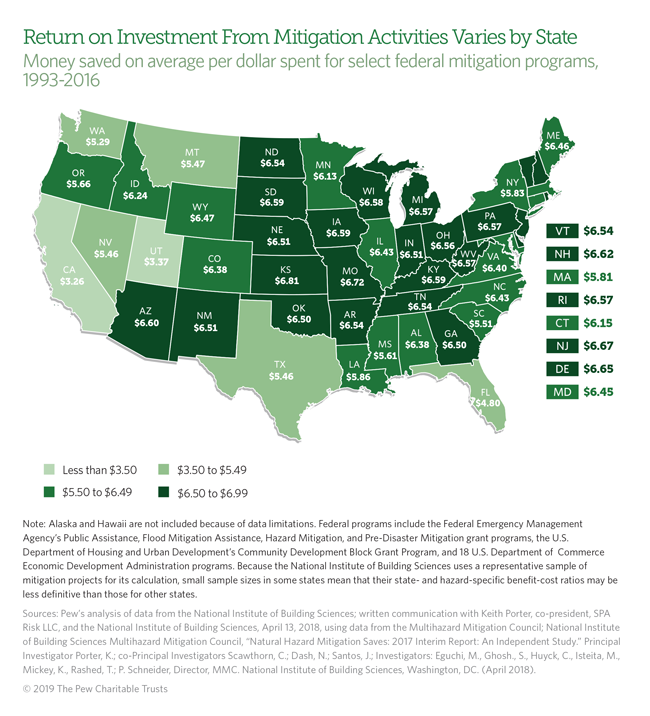Connecting state and local government leaders
Returns on investment vary across jurisdictions and hazard type.
Every federal grant dollar spent on natural disaster mitigation projects, such as elevating buildings or retrofitting infrastructure to reduce the impact of future events, saves $6 on average in post disaster recovery costs, according to a 2018 study by the National Institute of Building Sciences (NIBS).
But as with all federal spending, the outcomes differ from state to state, with estimated benefits ranging from nearly $7 saved for each $1 spent in Kansas to just over $3 for every $1 invested in California between 1993 and 2016. The NIBS analysis also shows variation in potential savings across different natural hazards, such as floods, high winds, earthquakes, and wildfires. Understanding the differences in state- and hazard-specific returns on spending can help state policymakers as they evaluate opportunities to invest in mitigation, using both state and federal funding.
Calculating Mitigation Savings
The study looks at the benefit-cost ratios, or the amount of savings that result from a specified level of investment. NIBS measures savings from mitigation activities by calculating estimated reductions in disaster impacts such as property repair costs, casualties, business interruptions, and administrative fees associated with insurance. The investments come in the form of federal spending on 23 grant programs administered by the Federal Emergency Management Agency (FEMA), the Economic Development Administration (EDA), and the Department of Housing and Urban Development (HUD), combined with any state and local funds required to match some of those programs. (See “Methodological note” below for more details.)
NIBS did not include spending on mitigation activities performed directly by the federal government, like U.S. Army Corps of Engineers flood control projects or U.S. Department of Agriculture prescribed burns, in its analysis. (See “Agencies and programs providing grant data” for more details.) Taken together, these benefits and costs result in the nationwide ratio of nearly $6 to $1.
State-by-State Data Reveal Differing Results for Mitigation Investment
Based on underlying data provided by NIBS, Pew determined that among the contiguous 48 states, the savings from mitigation investments ranged from $6.81 to $1 spent in Kansas to $3.26 to $1 in California. (See Figure 1.) Alaska and Hawaii were not included in NIBS’s analysis because of data limitations. Because NIBS uses a representative sample of mitigation projects for its calculation, small sample sizes in some states mean that their state- and hazard-specific ratios may be less definitive than those for other states.

Benefits Vary by Disaster Type
In addition to calculating an overarching national ratio of benefits to federal mitigation spending, NIBS analyzed the numbers from 1993 through 2016 across four natural hazards: floods, high winds, earthquakes, and wildfires. State differences reveal hazard-specific trends. (See Figure 2.):
- Flooding: All states received funding from the federal government to reduce future flood damage, for example by elevating or acquiring flood-prone buildings and retrofitting infrastructure. Nationally, savings were $6.55 to $1 in spending with state ratios ranging slightly from $6.70 to $1 in Arizona to $6.30 to $1 in Nevada. This was the smallest range among states for the four hazards studied.
- High winds: Federal grants went to 38 states to mitigate the effects of high winds, through activities such as adding shutters and safe rooms and reinforcing roofs and garage doors in residential, commercial, and public buildings. The national ratio was $5.57 in savings to $1 in spending and ranged more significantly than the other hazards in the study, from $7.33 to $1 in New Hampshire to $3.67 to $1 in Massachusetts.
- Earthquakes: Thirteen states received federal aid to reduce the impact of earthquakes by strengthening and retrofitting building components, including bracing generators, elevators, and other vital equipment. Across the country, savings averaged $2.79 to $1 in spending and ranged from $3.00 to $1 in Montana to $2.00 to $1 in Indiana.
- Fires: Eleven states received federal aid to mitigate the impact of wildfires, for example by replacing roofs with fire-resistant materials, limiting dead trees and other flammable vegetation around properties, and replacing wooden water tanks. The nationwide ratio was $3.22 in savings to $1 in spending and varied from $4.00 to $1 in Washington to $2.00 to $1 in New Jersey.
Click here to explore a data visualization that shows the return on investment from federal mitigation spending by state and disaster type.
Agencies and Programs Providing Grant Data
Three federal agencies provided NIBS with comparable grants data for 23 programs related to natural hazard mitigation for the period from 1993 through 2016. These include the Public Assistance, Flood Mitigation Assistance, Hazard Mitigation, and Pre-Disaster Mitigation grant programs administered by FEMA, HUD’s Community Development Block Grant Program, and 18 EDA programs.
Methodological Note
Spending refers only to grant aid provided to states, along with the state and local matching funds required by certain federal programs in the period examined. It does not include mitigation measures directly implemented by federal agencies, such as the construction and maintenance of flood-control systems by the U.S. Army Corps of Engineers or prescribed burns by the U.S. Department of Agriculture. Alaska and Hawaii are excluded due to data limitations associated with their hazard mapping information. For more information on the data used in NIBS’s analysis, see “Natural Hazard Mitigation Saves: 2018 Interim Report” p. 213.
NIBS uses a representative sample of mitigation projects for its calculation, and small sample sizes in some states mean that their state- and hazard-specific ratios may be less definitive than those for other states. More information on this and other aspects of NIBS’s methodology can be found on page 123 of “Natural Hazard Mitigation Saves: 2018 Interim Report.”
Anne Stauffer is a director, Colin Foard is an associate manager, and Errol Spence is an associate with The Pew Charitable Trusts’ fiscal federalism initiative.
NEXT STORY: Requiring High Schools to Name Valedictorians



